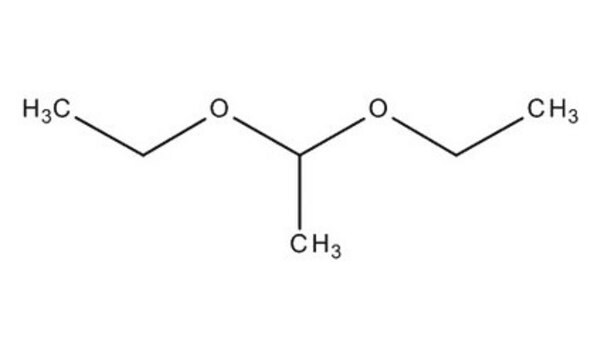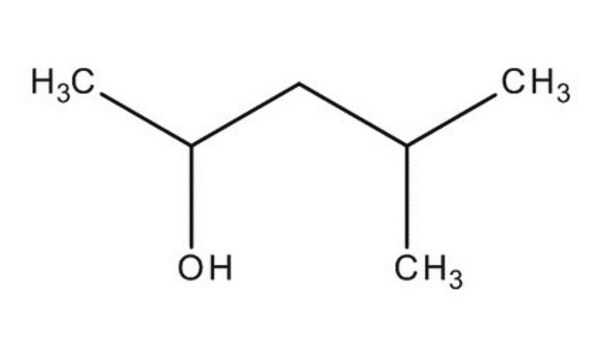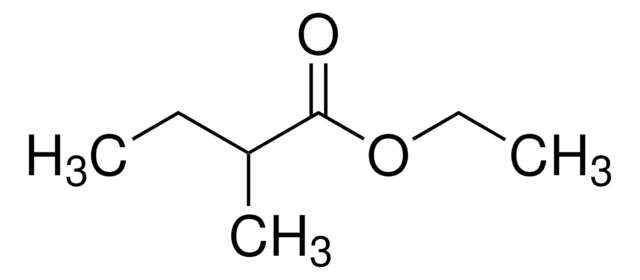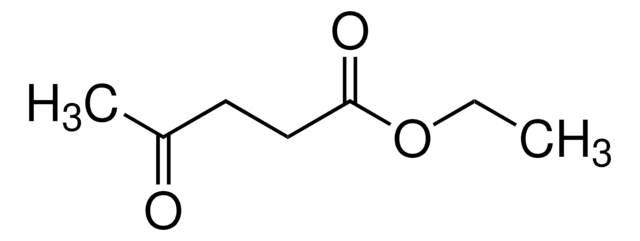Kluczowe dokumenty
W200220
Acetal
natural, ≥97%, FG
Synonim(y):
Acetaldehyde diethyl acetal, 1,1-Diethoxyethane, Acetal
About This Item
meets purity specifications of JECFA
Polecane produkty
klasa czystości
FG
Fragrance grade
Halal
Kosher
natural
agency
follows IFRA guidelines
meets purity specifications of JECFA
zgodność regionalna
EU Regulation 1223/2009
EU Regulation 1334/2008 & 178/2002
FDA 21 CFR 110
gęstość pary
4.1 (vs air)
ciśnienie pary
20 mmHg ( 20 °C)
8 mmHg ( 8 °C)
Próba
≥97%
temp. samozapłonu
446 °F
granice wybuchowości
10.4 %
współczynnik refrakcji
n20/D 1.379-1.383 (lit.)
bp
102 °C (lit.)
gęstość
0.831 g/mL at 25 °C (lit.)
Zastosowanie
flavors and fragrances
Dokumentacja
see Safety & Documentation for available documents
alergen pokarmowy
no known allergens
alergen zapachowy
no known allergens
Organoleptyczne
green; earthy; ethereal; vegetable; sweet
ciąg SMILES
CCOC(C)OCC
InChI
1S/C6H14O2/c1-4-7-6(3)8-5-2/h6H,4-5H2,1-3H3
Klucz InChI
DHKHKXVYLBGOIT-UHFFFAOYSA-N
Szukasz podobnych produktów? Odwiedź Przewodnik dotyczący porównywania produktów
Powiązane kategorie
Hasło ostrzegawcze
Danger
Zwroty wskazujące rodzaj zagrożenia
Zwroty wskazujące środki ostrożności
Klasyfikacja zagrożeń
Eye Irrit. 2 - Flam. Liq. 2 - Skin Irrit. 2
Kod klasy składowania
3 - Flammable liquids
Klasa zagrożenia wodnego (WGK)
WGK 2
Temperatura zapłonu (°F)
<68.0 °F - closed cup
Temperatura zapłonu (°C)
< 20 °C - closed cup
Środki ochrony indywidualnej
Eyeshields, Faceshields, Gloves, type ABEK (EN14387) respirator filter
Wybierz jedną z najnowszych wersji:
Masz już ten produkt?
Dokumenty związane z niedawno zakupionymi produktami zostały zamieszczone w Bibliotece dokumentów.
Klienci oglądali również te produkty
Protokoły
Separation of Acetone; Acetic acid; Propionic acid; Ethyl butyrate; Ethanol; Isoamyl acetate; Isobutyric acid; 3-Methyl-2-butanol; Methyl acetate; 1-Propanol; Acetal, ≥98%, FG; 2-Methyl-1-pentanol; Butyl acetate; Ethyl propionate; 3-Pentanol; 2-Pentanol, 98%; Ethyl isobutyrate; Isobutyl acetate; Acetaldehyde; Furfural; Butyric acid; Methanol; Ethyl acetate
Global Trade Item Number
| SKU | GTIN |
|---|---|
| W200220-4KG-K | 4061838107923 |
| W200220-5KG-K | |
| W200220-100G-K | 4061837488771 |
| W200220-1KG | |
| W200220-1KG-K | 4061837488788 |
| W200220-100G | |
| W200220-4KG | |
| W200220-SAMPLE | |
| W200220-SAMPLE-K | 4061837488795 |
Nasz zespół naukowców ma doświadczenie we wszystkich obszarach badań, w tym w naukach przyrodniczych, materiałoznawstwie, syntezie chemicznej, chromatografii, analityce i wielu innych dziedzinach.
Skontaktuj się z zespołem ds. pomocy technicznej













